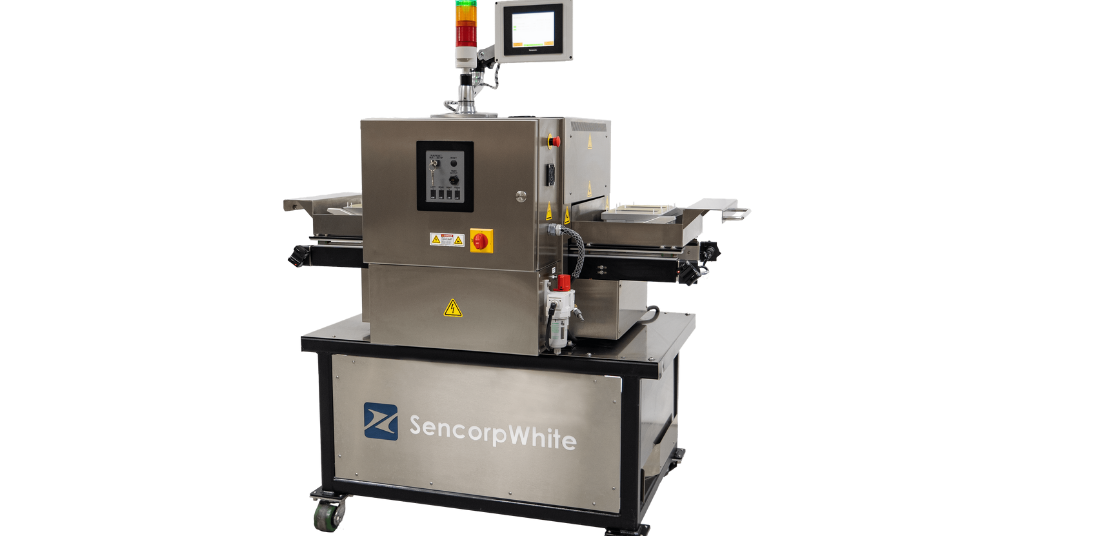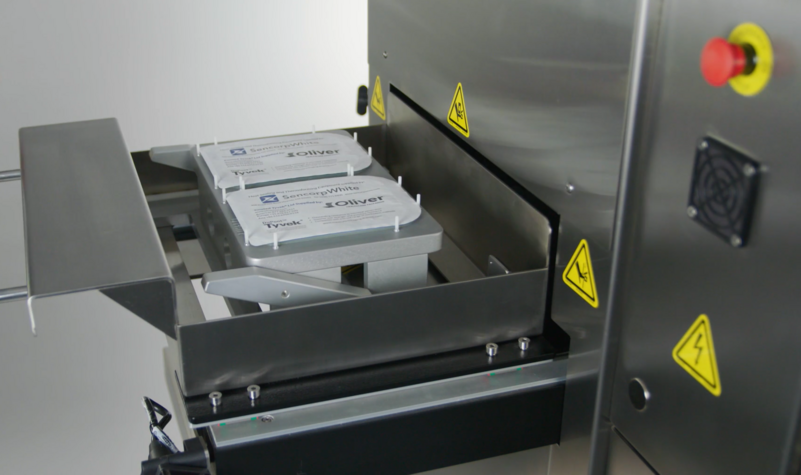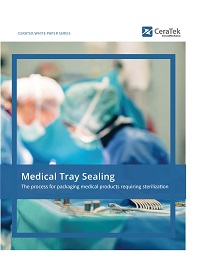A Guide to Medical Tray Sealing

In our A Guide to Understanding Medical Pouch Sealing resource, we discuss the sealing process that is used within the medical device and life science industries for packaging medical products that require sterilization. This guide is divided into 8 sections and dives deeper into the overall need and the validating process to ensure a sterile seal.
Tray Sealing 101

What is tray sealing?
Tray sealing is a packaging process that binds a flexible, die-cut lid to a pre-formed, rigid tray that contains whatever it is that needs to be packaged. Usually, the lid is made from thin material such as Tyvek, laminated foil, paper, or film, and the tray is made from a rigid or semi-rigid plastic such as PETG.
Tray sealing is commonly used for packaging medical devices, particularly when clamshell packaging or blister sealing are not applicable. Tray sealing prevents products from moving in the tray during shipping and creates a hermetic seal so that products can be stored and shipped under sterile conditions.
Types of materials used for tray sealing
Tray and lid materials are carefully selected based on their inherent properties and the specific needs of the products being packaged. For medical tray sealing, the most common lid stock is Tyvek, and the most common tray material is PETG—because both of these materials are well-suited for sterilization. Alternative tray materials may be used for products requiring specific vapor transmission rates or other internal atmospheric conditions ( e.g., HDPE offers a higher vapor barrier than PETG).
Likewise, some products may be light sensitive and require an opaque tray material, while others may need more protection during shipping and therefore may be best packaged in materials that can resist cracking if dropped. For lids, a manufacturer might opt for foil rather than Tyvek if the sterilization process is not a concern and there is a need for additional puncture resistance, more moisture control, or a light barrier.
Products shipped and stored in sealed trays
Tray sealing is commonly used in the medical device industry to package products that need to be shipped and stored under sterile conditions. These types of medical devices cannot be packaged using clamshells because clamshells rely on snap closures and cannot be hermetically sealed. By contrast, tray sealing completely bonds the lid to the tray, enabling a hermetic seal. In addition, these products are typically high-value medical devices, such as joint replacements and implants, that need to be packaged so that they are immobilized and yet readily accessible and presentable in medical settings. It is easiest to do this using a tray, rather than a flexible pouch. Sealed trays also provide better puncture resistance than clamshells or pouches.
[Take it with you. Download the Guide to Understanding Medical Tray Sealing]
The Medical Tray Sealing Process

What is the medical tray sealing process?
Medical tray sealing involves applying a specific temperature for a specific amount of time under a specific pressure so that the lid and tray materials are bonded together. First, the rigid plastic tray, usually empty, is placed into a tool in the tray sealing machine. Then, an operator manually places the product in the tray and rests the lid stock on top. Next, the tray is shuttled into the tray sealing machine where the correct temperature, time, and pressure are applied. Once the sealing is complete, the tray exits the tray sealer and the operator unloads the finalized sealed package.
Achieving a good bond between the lid and the tray requires an exceptionally flat and parallel sealing platform, as well as the highly regulated and consistent application of temperature and pressure. To achieve a hermetic seal, it is critical for the both the lid and tray to conform and make intimate contact all the way around the perimeter of the tray. That means the tray sealer must accommodate for the inherent variability of lid and tray materials by being accurate and consistent.
The difference between tray sealing and pouch sealing
The process used for tray sealing is similar to the one used for pouch sealing; however, the two processes do differ in significant ways. For example, with pouch sealing, two flexible materials are bonded together. With tray sealing, a flexible material (lid) is bonded to a rigid material (tray). In addition, pouch sealing involves bonding a narrow band across the top of the pouch, while tray sealing involves applying consistent temperature and even pressure over a much wider area. In fact, comparing the average tray versus the average pouch, the amount of seal area is quadrupled. That means tray sealing requires a larger press area and greater control over the application of temperature and pressure.
How medical device tray sealing differs than other types of sealing
The most important difference between medical device tray sealing and other types of sealing is that the materials used for the tray and the lid must be able to be bonded together to create a package that can be sterilized and maintain sterility over the shelf life of the product. In many cases, it is also important that the tray is designed to immobilize the product. Tray sealers used to package medical devices feature very precise systems for controlling time, temperature, and pressure during the sealing process. In fact, this level of accuracy and repeatability is what separates medical device tray sealers from other types of sealers. For packaging equipment to be even considered capable of sealing medical trays, it must be validatable, meaning that the sealer must be verified to provide the same results repeatedly with very little to no deviation.
[Take it with you. Download the Guide to Understanding Medical Tray Sealing]
How Sealed Trays Are Sterilized

The different types of sterilization processes used with tray sealing
Tray sealing is commonly used to package medical devices that need to be shipped and stored under sterile conditions. The sterilization process happens post-packaging, i.e., after the sealed package has exited the tray sealer. The sealed tray is sent to a sterilization facility which applies one of these sterilization processes: ethylene oxide (EtO) sterilization, electron beam (e-beam) sterilization, radiation sterilization, or steam sterilization.
EtO sterilization is the most common process used to sterilize medical devices packaged in sealed trays; however, it does require at least some part of the packaging material to be permeable and yet able to maintain a sterile barrier. That is why medical devices packaged with Tyvek or medical paper are often sterilized using EtO. In the case of a sealed tray with a lid made of Tyvek, the EtO gas passes through the Tyvek material, killing any contaminating microorganisms that are inside the package.
Then, the pressure is relieved, as regular air is pumped back into the sterilization chamber, dispersing the EtO gas. The Tyvek fibers are bonded in a way that prevents penetration by microorganisms while allowing penetration by air molecules, which are much smaller. As a result, as long as the tray remains sealed, the contents are sterile.
Some sealed trays are sterilized using electron beam (e-beam) sterilization or radiation sterilization. These sterilization processes are ideal for sealed trays made from materials with little to no permeability like foils or plastics, or for products that are very dense. As the names imply, e-beam sterilization uses electron beams to sterilize the medical product after packaging, and radiation sterilization uses radiation, usually in the form of high energy gamma rays.
Lastly, sealed trays can also be sterilized using high temperature and pressure (i.e., steam). Products and packaging that are sterilized by steam must be able to withstand high temperatures and possibly condensation. Steam sterilization cannot be used if there is concern that process could create water vapor or droplets that affect the product packaged in the sealed tray.
[Take it with you. Download the Guide to Understanding Medical Tray Sealing]
Types of Medical Tray Sealers and Options

Types of sealers used for tray sealing medical products
Among all the different types of available sealers, constant heat sealers are the best choice for tray sealing. Constant heat sealers heat up to a set point temperature and then are very stable at that temperature. The typical cycle time on a constant heat sealer used for tray sealing applications is two to three seconds. While impulse sealers could be used for tray sealing, they require the heating bar to rise to temperature and cool down with every cycle.
That creates an impulse cycle time of about ten seconds, which is significantly longer than the cycle times possible with a constant heat sealer. In addition, because the thermodynamics change with every cycle on an impulsive sealer, it does not lend itself to the highly accurate and repeatable systems that are required for tray sealing medical devices. Impulse sealers are typically used for packages used in consumer markets, i.e., clamshell packaging where two plastic pieces are bonded together to create a weld seal.
Like impulse sealers, rotary sealers and cantilever sealers are not well-suited for sealing medical trays. To achieve a hermetic seal, it is critical for the both the lid and tray to conform and make intimate contact all the way around the perimeter of the tray. That means the tray sealer used must accommodate for the inherent variability of lid and tray materials by being extremely accurate and consistent, and there must be very tight parallelism across the entire sealing platform. Since cantilever sealers move in an arc, they are not able to offer the required parallelism.
Types of configurable options for tray sealers
Tray sealers can be configured with a few different options. For example, the shuttle movement of the tool into and out of the sealer can be designed to be semi-automated. Manufacturers need to weigh various pros and cons when determining whether this type of automation is advantageous.
On the one hand, configuring a tray sealer to be semi-automated can provide greater repeatability and free the operator for other tasks, such as pre-kitting or inspection, and that could potentially increase throughput. However, for safety reasons, semi-automating a tray sealer typically creates a process that is slower than if the operator was working unassisted. That can increase cycle time and decrease output.
Tray sealers can also be configured with barcode scanning. A barcode scanner can be used to ensure that the correct recipe is loaded onto the tray sealer for the next run and to verify that the tool that is loaded is the correct one for the recipe that is currently running. Other options, such as in-line non-destructive seal inspection are currently in development.
[Take it with you. Download the Guide to Understanding Medical Tray Sealing]
The Benefits of Sealed Trays and Upward Trends

The benefits of sealed trays compared to pouches and clamshells
Sealed trays offer benefits that pouches and clamshell packaging cannot. The major advantage is product protection. A sealed tray protects a medical device for the entirety of its shelf life—through the sterilization process, shipping and distribution, storage, and ultimately, until the product is opened under sterile conditions and used in a medical setting.
For instance, many medical devices have to be unsealed and presented in a controlled manner by scrub nurses to surgeons in the operating room. Sealed trays are much better suited for this compared to flexible pouches. With a sealed tray, the nurse can peel off the lid to expose the medical device positioned in a rigid, robust platform. In certain instances, the sealed tray is designed so that the medical device can be presented in a specific way. In other instances, once the tray is opened it becomes part of the product preparation, serving as an area for mixing chemicals before a stent is placed in an artery, for example.
Pouches and clamshell packages cannot be used in the same way. Pouches do not have the rigid structure of a tray, and clamshells cannot maintain product sterility, nor offer easy opening. The main disadvantage to tray sealing is the cost. Sealed trays usually cost more than pouches.
Why the use of tray sealing is trending upward
The use of tray sealing is trending upward for two main reasons.
First, compared to pouches, sealed trays can offer better protection over a product’s entire shelf life. Second, many manufacturers are moving to tray sealing because there is a growing perception that products packaged in trays have a higher value than those packaged in pouches. Of course, manufacturers that want to move to tray sealing will need to re-evaluate their heat sealers. Achieving a hermetic bond between the lid and the tray requires an exceptionally flat and parallel sealing platform, as well as the highly regulated and consistent application of temperature and pressure.
[Take it with you. Download the Guide to Understanding Medical Tray Sealing]
Creating and Testing a Hermetic Seal

To determine the optimal temperature, time, and pressure to use, manufacturers must first conduct a design of experiment (DOE) in which different temperatures, pressures, and dwell times are tried on a 3D model. Then, destructive testing is used to determine which combination of temperature, pressure, and time is best. After that, the tray sealer must also be periodically validated to ensure that it is applying those optimal parameters repeatably, with little to no variability.
Types of destructive testing for sealed trays
Destructive testing on tray sealing applications in the medical device industry is typically conducted using tensile testing, burst testing, or dye penetration testing.
These tests are used to establish that the sealed tray has reached minimum barrier system properties. For example, tensile testing applies tensile (pulling) forces to determine the minimum pounds required to break the seal. Burst testing pressurizes the package until the seal is broken and can be used to identify the weakest point on the lid, tray, or seal. Dye penetration is a qualitative test of the seal; if dye penetrates to the inside of the package, then the seal is not sufficient.
Repeatedly creating a hermetic seal
Tray sealers must be carefully designed and properly installed to meet the medical device industry’s standards for accuracy and repeatability.
For example, both the top and bottom heating elements of the sealer must be under tight control to ensure that the sealing temperature is maintained within a very narrow window. In many instances, the top heating element is maintained at the sealing temperature and the bottom part of that system is unheated; however, over many cycles, heat can build up on the bottom side. That means the bottom side must be repeatedly cooled.
Any deviation in the temperature, pressure, or time used to create the hermetic seal increases the risk of lowering accuracy and repeatability.
[Take it with you. Download the Guide to Understanding Medical Pouch Sealers]
How Tray Sealers Are Validated

Statistical terms used in tray sealing: CPK and standard deviation
Process capability (CPK) is a statistical measurement that describes the accuracy and repeatability of a tray sealing process. Using an archery target as a metaphor, an ideal tray sealing process is like getting a tight grouping of arrows in the bullseye. A tight clustering of arrows on the target, but not on the bullseye, shows repeatability, but not accuracy.
An occasional arrow on the bullseye shows some accuracy, but little repeatability. The best tray sealing processes are both accurate and repeatable. Historically, the medical device industry has assigned that goal a CPK value of 1.3. The medical device industry is now moving away from a minimum required CPK to a CPK of what is the maximum achievable given a package’s design.
Standard deviation is another statistical measurement that describes the amount of variation or dispersement in a set of values. It provides another way of looking at process capability (CPK). Manufacturer continually eye process improvements to be able to defend the highest possible CPK, not just what is an acceptable CPK.
Processes used for validating tray sealers: IQ, OQ, and PQ
The processes that are used for validating a tray sealer are installation qualification (IQ), operation qualification (OQ), and process qualification (PQ). The IQ process enables a user to verify that their tray sealer is installed correctly according to the vendor’s instructions. Then during the OQ process, the user can verify that the tray sealer is operating in a reliable, repeatable manner and producing the expected output.
Finally, during the PQ process, operator actions for interfacing with the equipment are assessed. Many heat sealer vendors can offer IQ and OQ documents, or at least some level of support documentation. It is difficult for them to offer PQs because key components of the PQ are the package itself and operator functions, both of which are independent of the vendor.
Tray sealer validation is an ongoing process
In the medical device industry, tray sealers must be validated for repeatability and accuracy. The industry standard is that this validation process happens annually when the sealers are calibrated. At that time, any margin of error that has creeped into the system is corrected, so that from year to year, the output is stable. Most medical device manufacturers validate their tray sealers annually. Others calibrate their tray sealers every six months or so.
[Take it with you. Download the Guide to Understanding Medical Tray Sealing]
Choosing A Tray Sealing Vendor

Second, make sure the tray sealer manufacturer has the flexibility to customize what they offer as a standard product. Rather than be limited by off-the-shelf offerings, you want a vendor that can source a piece of equipment that addresses your specific concerns and packaging challenges.
Lastly, the tray sealer vendor you choose should have a robust customer service and support system for assisting with determining sealing parameters. They do not necessarily need to offer design of experiment (DOE), but they should be knowledgeable enough about medical device packaging to help determine sealing parameters.
Ideally, the vendor you choose will also be able to offer installation support and training, along with field service for troubleshooting and retrofitting as your tray sealing needs change.
[Take it with you. Download the Guide to Understanding Medical Tray Sealing]
Take it With You
Download the Guide in pdf format.


